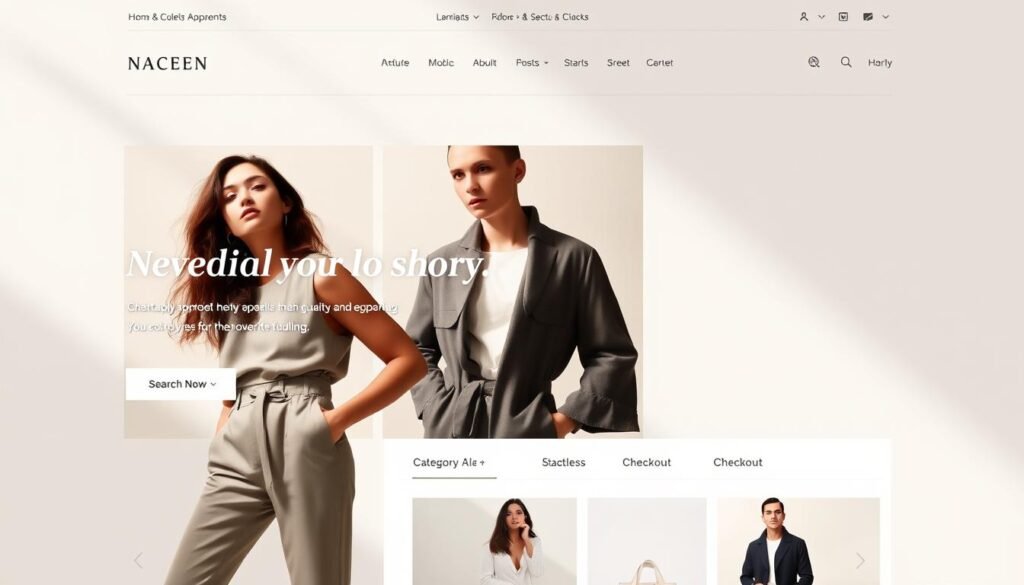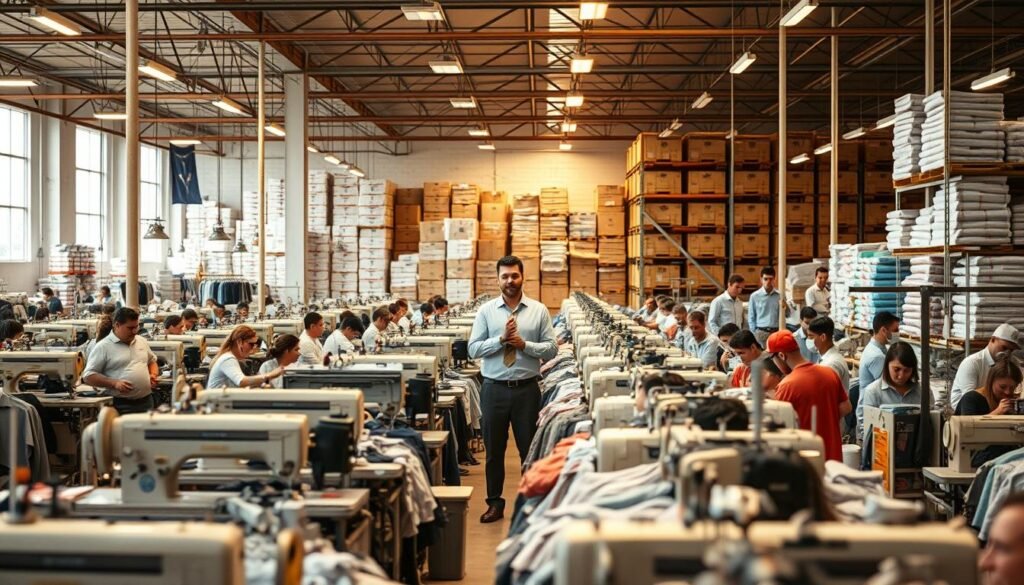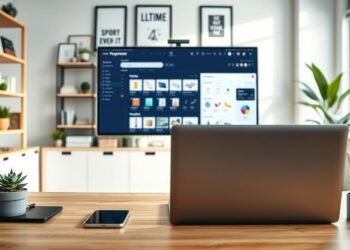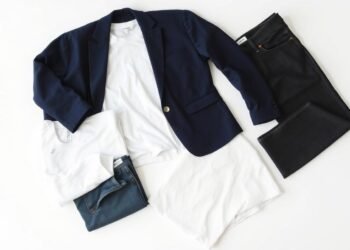Ever wondered why some fashion brands skyrocket while others fade away? The secret lies in a strategic approach—combining market insight, smart planning, and execution. Launching a successful venture in the U.S. fashion industry requires more than just creativity. It demands precision, legal awareness, and scalable solutions.
From niche selection to trademark hurdles, new entrepreneurs face countless challenges. Industry leaders like Mercedes Smith (Blackstrad) and Jennifer Johnson (True Fashionistas) emphasize the importance of research and adaptability. Whether it’s budget-friendly production or e-commerce optimization, every step matters.
Key Takeaways
- Identify a profitable niche with strong demand.
- Understand legal requirements to avoid delays.
- Learn from successful founders’ real-world experiences.
- Optimize online presence for better visibility.
- Balance quality and cost in manufacturing decisions.
Introduction to Starting Your Clothing Business
Launching a fashion brand today means tapping into a $1.7 trillion market fueled by shifting consumer preferences. With 73% of buyers choosing brands that align with their values, standing out requires more than just stylish designs. It demands a deep understanding of your audience and the competitive landscape.
Why the Fashion Industry Offers Opportunities
The global apparel market grows annually, driven by e-commerce and niche demand. Brands like Blackstrad achieved 200% year-over-year growth by addressing unmet needs—musicians struggling with formalwear. Meanwhile, wellness-focused labels such as Etalon adapted to trends, proving agility is key.
However, pitfalls exist. Guava Jammies faced $1,000+ in unexpected compliance fees for children’s sleepwear. Trademark conflicts and poor trend forecasting sink many startups. Success hinges on balancing creativity with practicality.
Key Success Factors for New Clothing Brands
Clear brand values attract loyal customers, as Forbes research confirms. Start by analyzing five metrics: customer acquisition cost, repeat purchase rate, average order value, inventory turnover, and social engagement. These reveal early-stage viability.
For a small business, minimizing risks means researching regulations and securing trademarks early. Identify your target customers through surveys or competitor analysis. The market rewards those who blend innovation with data-driven decisions.
Developing Your Fashion Business Concept
Differentiation is the lifeblood of fashion startups, separating fleeting trends from lasting brands. A Shopify study reveals 68% of thriving labels invest over six months refining their identity before launching. This phase determines whether your clothing brand becomes a market leader or gets lost in the crowd.
Identifying Your Unique Brand Identity
Define your brand pillars using a workshop-style framework. Ask: What values will your products embody? How will they solve customer pain points? Le Réussi’s trademark dispute taught designers to secure intellectual property early—avoiding costly rebrands.
Vaute Couture dominated the vegan winter coat market by aligning its design ethos with animal-conscious buyers. Their success underscores the power of a mission-driven narrative. Practical exercises like mood boards and competitor gap analysis help crystallize your unique angle.
Finding Your Niche in the Market
Athleisure brands grew 300% faster than formalwear last year, but sustainability-focused suits now carve a $2B niche. Use a matrix to compare opportunities: assess demand, competition, and scalability. For example, petites or extended sizes often represent untapped markets.
Tools like SEMrush or Google Trends reveal pricing and styling white spaces. When you start clothing ventures, remember: specificity attracts loyal audiences. Micro-niches—think eco-friendly maternity wear or gender-neutral work apparel—often yield higher margins.
Conducting Market Research
Smart market research separates thriving fashion labels from struggling ones. Without insights into customer needs and competitor gaps, even the most creative designs may falter. Data-driven decisions reduce guesswork and align your brand with real demand.
Analyzing Your Target Audience
True Fashionistas’ 10-factor profile template simplifies audience analysis. Track demographics (age, location) and psychographics (values, hobbies). For example, eco-conscious buyers pay 15% more for sustainable materials.
Use free tools like Google Analytics or Instagram Insights to validate assumptions. Surveys and focus groups reveal pain points—like petite shoppers struggling with sleeve lengths. This research shapes your product and messaging.
Studying Competitor Brands
SWOT analysis uncovers rivals’ weaknesses. Note their pricing, fabric quality, and customer complaints. Brands like Allbirds succeeded by addressing discomfort in traditional sneakers.
Monitor trends on Pinterest and TikTok with tools like Trendalytics. LegalZoom’s compliance checklist helps avoid fines—like flammability standards for sleepwear. Compare wholesale platforms (Faire vs. Alibaba) for cost-efficient sourcing.
USPTO trademark searches prevent legal clashes. Register your brand name early, as Le Réussi learned after a costly rebrand. Retailers who skip this step risk losing their identity.
Creating a Business Plan
Behind every thriving apparel brand lies a meticulously crafted roadmap. Your business plan serves as both compass and contract—guiding decisions while attracting investors. Stylebuy’s transition from sole proprietorship to LLC enabled wholesale partnerships, proving structure impacts scalability.
Essential Components for Fashion Startups
Startup costs range from $500 for print-on-demand to $50,000 for cut-and-sew operations. Guava Jammies’ 14-point compliance checklist prevents costly oversights like flammability testing delays.
Include these in your plan:
- COGS calculations for fabric, labor, and shipping
- Break-even analysis with realistic sales projections
- Marketing budget allocation across channels
Financial Projections and Funding Options
Compare SBA loans (avg. 6% interest) versus Kickstarter campaigns (avg. $25k raised). ZenBusiness LLC packages streamline legal setup for under $300, ideal for emerging brands.
Manage money wisely with 60-day inventory cycles. Use tools like QuickBooks to track raw material expenses against financial projections. Seasonal demand spikes require buffer capital—plan for 3-month reserves.
Designing Your Clothing Line
Great fashion brands are born when creativity meets precision in the design studio. This phase transforms your vision into wearable art while solving practical challenges. Project Runway’s Sarah Donofrio attributes her success to treating sketches as “blueprints for storytelling.”
Developing Your Signature Style
Your designs should reflect a distinct point of view. Start by analyzing three elements: color psychology, silhouette preferences, and fabric behavior. Sustainable brands like Reformation use mood boards to align aesthetics with eco-values.
Technical specification sheets prevent costly errors. Include:
- Stitch types and seam allowances
- Fabric weight and stretch percentages
- Hardware placement diagrams
Digital tools streamline the process. Adobe Illustrator offers advanced pattern-making skills, while Canva Pro suits beginners with pre-sized templates. Fit models—often recruited via local fashion schools—help perfect proportions.
Creating Technical Sketches and Prototypes
Prototyping costs vary dramatically. Local sampling runs $75-$300 per piece, while overseas options start at $25. The trade-off? Faster iterations versus lower quality control.
Smart startups use digital pattern-making software like CLO3D to visualize drape and fit before cutting fabric. This reduces material waste by up to 30% according to WGSN data.
Remember: Your first line sets the tone. Test prototypes with focus groups to refine details. As Donofrio advises, “Design is 10% inspiration and 90% iteration.” This hands-on experience separates hobbyists from professionals.
Sourcing Materials and Production
Material sourcing and production decisions make or break fashion brands before the first stitch is sewn. Smart choices here determine your product quality, profit margins, and ability to start selling quickly. Industry leaders like Blackstrad prove this—their shift to Chinese manufacturing slashed costs by 40% while maintaining quality.
Finding Quality Fabric Suppliers
New businesses should vet suppliers using Maker’s Row’s 5-point checklist: material certifications, sample quality, payment terms, and environmental compliance. Detroit Denim’s quality control protocol requires three test batches before full production.
Always negotiate MOQs (minimum order quantities). Many mills offer 30-50% reductions for first-time orders. For sustainable fabrics, look for GOTS or OEKO-TEX certifications—these appeal to eco-conscious shoppers.
Choosing Between Local and Overseas Manufacturing
Local workshops offer faster turnaround and better quality control but cost 3-5x more than overseas options. Alibaba suppliers can cut expenses, but require rigorous vetting—check at least 10 client references.
Factor in hidden costs like freight forwarding and import duties. A $5/unit overseas item often becomes $8 after logistics. For small batches under 500 units, domestic production often makes better financial sense.
Establishing Your Brand Identity
Visual branding isn’t just about aesthetics—it’s the foundation of customer trust and recognition. Forbes reports 83% of consumers associate logos and color schemes with Shopify brands instantly. A cohesive identity fuels marketing success across your online store, packaging, and social media.
Crafting a Memorable Brand Name and Logo
Your brand name should resonate emotionally while being legally available. Use USPTO’s trademark database to avoid conflicts like A-Morir’s rebrand after a legal dispute. Their bold eyewear designs for celebrities thrived once the name was secured.
Building Cohesive Visual Branding
Tools like Canva Pro simplify logo design, but Adobe Express offers advanced customization for typography and palette precision. A style guide ensures consistency—define hex codes, font pairings, and image filters early.
Packaging costs average $2–$8 per unit for custom boxes with eco-friendly finishes. Test designs with focus groups; 72% of buyers recall brands by their unboxing experience. Sync every touchpoint, from Instagram posts to shipping labels, for omnichannel impact.
Setting Up Legal Business Structure
Legal protection forms the backbone of any successful fashion venture. The right structure shields personal assets and streamlines taxes. Whether you start business as a solopreneur or with partners, this decision impacts scalability and compliance.
LLC or Sole Proprietorship: Key Differences
An LLC limits personal liability but costs more to form. LegalZoom offers $0 + state fee setups, ideal for small business owners. Sole proprietorships are simpler but expose personal assets to lawsuits.
Multi-member LLCs need operating agreements to outline profit splits. Check state-specific rules—Hawaii requires flammability testing for keiki (children’s) sleepwear. These costs vary widely by location.
Licenses, Permits, and Trademarks
Seller’s permits are mandatory in most states. Home-based operations must comply with zoning laws. Business insurance (general liability or product coverage) mitigates risks.
Trademark registration takes 12+ months via USPTO. Delays can derail a business launch. Include these steps in your plan to avoid last-minute hurdles.
Pricing Your Products Strategically
The right price tag does more than cover costs—it defines your brand’s position in the market. Underprice, and you risk devaluing your product; overprice, and you lose customers. Industry leaders like KOTN prove strategic pricing fuels long-term growth.
Calculating Production Costs
Start with a COGS worksheet that includes hidden expenses. Fabric waste adds 8–12% to material costs, while labor varies by region. True Fashionistas’ template factors in consignment fees—critical for small-batch brands.
Dynamic tools like Craftybase adjust for seasonal money fluctuations. For example, organic cotton prices spike in Q2. Build a 15% buffer into your budget to absorb these shifts.
Determining Retail Markup and Profit Margins
Luxury brands use 2.5–3x markup, while fast fashion averages 2.2x. KOTN’s premium pricing strategy leverages storytelling—their $98 tees highlight ethical sourcing. Test psychological pricing: $49.99 outperforms $50 by 12%.
Wholesale partnerships require balancing margins. A 50% wholesale discount means doubling your base price. Use Shopify’s breakeven calculator to model scenarios before committing.
Building Your Online Presence
In today’s digital era, your fashion brand’s online footprint is as crucial as its designs. Over 60% of purchase decisions begin with digital discovery, making your virtual storefronts indispensable assets. Platforms like Shopify offer 14-day free trials with $29/month starter plans—ideal for testing your concept.
Crafting Your Digital Storefront
Your website serves as headquarters for brand storytelling and sales. Prioritize mobile-first design—87% of shoppers browse on phones. Include high-resolution product galleries, size guides, and secure checkout.
Email lists build anticipation pre-launch. Offer exclusive previews to subscribers. Tools like Klaviyo integrate seamlessly with most online store platforms, automating personalized campaigns.
Mastering Social Platforms
Instagram Shopping turns profiles into catalogs. Meet their requirements: business account, product catalog connection, and compliance with commerce policies. Post consistently using content calendars—plan two weeks ahead.
User-generated content boosts trust. Encourage customers to share styled looks with branded hashtags. Feature these across channels to showcase real-life appeal.
Track performance through analytics dashboards. Monitor bounce rates on your social media links and conversion paths. Adjust your marketing mix based on what drives engagement.
Developing Your Marketing Strategy
The right marketing mix can amplify your brand’s voice and drive sales faster than any runway show. With 92% of fashion startups investing heavily in Instagram, digital channels dominate discovery. But winning requires more than just posts—it demands a strategic blend of paid, owned, and earned media.
Digital Marketing for Fashion Brands
Instagram’s visual nature makes it ideal for fashion marketing. Carousel posts showcasing fabric textures perform 38% better than single images. Use Instagram Shopping tags to turn inspiration into instant purchases.
Google Shopping feeds need optimization too. Include color variants and size options in product titles. Tools like Feedonomics automate updates when inventory changes. This keeps your target audience seeing current stock.
Email nurtures long-term relationships. Segment lists by purchase history—send loyal customers early access to new lines. Abandoned cart flows recover 15-20% of lost sales with timely reminders.
Influencer Collaborations and PR
Micro-influencers (10K-50K followers) drive 3x more engagement than mega-stars. Draft contracts specifying content expectations and usage rights. Le Réussi’s legal team reviews all agreements to protect their trademark.
PR outreach requires sharp angles. Pitch editors on how your designs solve problems—like wrinkle-resistant fabrics for travelers. Include high-res lookbook images and sample availability dates.
Pop-up shops create buzz while testing new markets. Calculate ROI by tracking foot traffic versus online conversions from geo-targeted ads. Affiliate programs extend reach through retailers and stylists who earn commissions on referrals.
Managing Inventory and Fulfillment
Efficient inventory management separates profitable fashion brands from those drowning in excess stock. With a 25% average return rate in e-commerce, optimizing logistics is non-negotiable. Smart systems balance real-time tracking with costs, ensuring you start selling without bottlenecks.
Inventory Control Systems
Third-party logistics (3PL) providers like ShipBob and Deliverr automate stock updates across channels. Compare their business models: ShipBob suits high-volume sellers, while Deliverr excels in fast Amazon integrations.
Prevent deadstock with these tactics:
- Use dynamic forecasting tools like Cin7 to align production with demand.
- Negotiate flexible MOQs with suppliers to avoid overordering.
- Liquidate slow-moving products via flash sales or B2B marketplaces.
Shipping and Returns Processes
Returns impact profitability but can enhance customer experience if handled well. Partner with returns management platforms like Loop or Happy Returns to automate labels and exchanges.
Sustainable packaging options matter too. EcoEnclose offers compostable mailers, while noissue provides customizable recycled boxes. Both align with eco-conscious buyer expectations.
For warehouses, optimize layouts with ABC analysis—prioritize fast-selling items near packing stations. This cuts fulfillment time by up to 30%.
Exploring Sales Channels
Choosing the right sales channels can make or break your fashion brand’s profitability. With a 60% margin difference between direct-to-consumer (DTC) and wholesale models, your strategy impacts both revenue and brand control. Diversification mitigates risks while expanding your reach.
Direct-to-Consumer vs. Wholesale
DTC channels like e-commerce stores offer higher margins but require robust marketing to attract customers. Shopify brands retain 70-80% of each sale, versus 30-50% with wholesale. Tools like Faire simplify B2B transactions with pre-made line sheets.
Wholesale suits brands targeting boutiques or department stores. Negotiate terms carefully—consignment agreements should specify payment timelines and unsold product returns. Always factor in trade show costs ($500-$5,000 per event).
Pop-Up Shops and Market Stalls
Temporary retail spaces create buzz in high-traffic areas. Local permits range from $50 (Austin) to $400 (NYC) daily. Pair pop-ups with geo-targeted Instagram ads to drive foot traffic.
Insurance is non-negotiable. General liability coverage averages $1,200 annually. For market stalls, use portable POS systems like Square to sync inventory in real time. This prevents overselling across channels.
To start selling successfully, test channels with small batches. Track which market delivers the best ROI before scaling. Multi-platform tools like Cin7 keep stock levels accurate everywhere.
Building Industry Relationships
The fashion industry runs on relationships as much as it does on fabric and thread. Successful brands cultivate networks that span suppliers, retailers, and mentors. These connections provide market insights, crisis support, and growth opportunities.
Networking with Suppliers and Retailers
Strong partnerships with manufacturers prevent production delays. Stylebuy’s transition from sole proprietorship to LLC enabled wholesale contracts with major businesses. Their secret? Pre-negotiated terms covering minimum orders and defect resolutions.
Use these proven supplier tactics:
- Request sample batches before full production runs
- Clarify payment schedules in writing
- Visit factories personally when possible
For retailers, research their customer demographics first. Boutiques catering to petite sizes may reject oversized collections. Fashion Group International events offer prime networking with buyers.
Finding Mentors in the Fashion Industry
Seasoned professionals accelerate your learning curve. Platforms like SCORE connect designers with retired executives. Many offer free consultations to share experience about fabric sourcing or import regulations.
Trade associations provide structured guidance:
- CFDA’s mentorship program pairs emerging talents with veterans
- Local chambers of commerce host industry mixers
- Textile associations share technical skills workshops
Collaborative projects build bonds naturally. Co-designing limited editions with established people introduces you to their networks. Always follow up with thank-you notes—small gestures foster lasting alliances.
Scaling Your Clothing Business
Growth in fashion demands strategic scaling—timing is everything. Rushing expansion drains money, while delaying it misses opportunities. Brands like OKAYOK grew 300% by phasing production increases over 18 months. Their model proves that successful clothing ventures balance ambition with data.
When to Expand Your Product Line
Start small with a core collection before adding variations. Analyze sales data: if 30% of customers request plus sizes, it’s time to diversify. Seasonal testing minimizes risk—launch swimwear as a summer capsule before committing to year-round stock.
Follow this framework for extensions:
- Plan around existing demand gaps (e.g., sustainable workwear).
- Budget for 3–6 months of runway to absorb new time and material costs.
- Certify as a B Corp if sustainability aligns with your brand ethos.
Hiring Your First Employees
Most fashion startups hire their first full-time staff at 18 months. Contractors handle short-term needs like photoshoots, but employees drive long-term growth. Legal distinctions matter—misclassifying workers risks fines up to $1,000 per violation.
Prioritize these roles early:
- Production manager to oversee quality control.
- Digital marketer for scaling customer acquisition.
- Fulfillment specialist if order volume exceeds 50/week.
International expansion requires deeper planning. Factor in tariffs, shipping logistics, and localized marketing. Always have an exit strategy—whether selling the brand or licensing designs.
Conclusion
Turning creative vision into a profitable venture requires patience and precision. Your clothing business journey starts with a solid foundation—research, planning, and adaptability.
Use this 12-month roadmap: finalize designs, secure trademarks, and test small batches. Resources like SCORE mentors or Material Bank streamline sourcing. Dalia’s success at 19 proves age isn’t a barrier—just focus on execution.
Avoid common first-year missteps: overordering inventory or neglecting cash flow. Protect your fashion brand early with LegalZoom’s LLC services.
Now, take action. Every successful clothing brand began with a single step—yours starts today.
FAQ
What makes the fashion industry a good business opportunity?
The fashion industry thrives on constant demand and trends, offering flexibility for creative entrepreneurs. Brands like Everlane and Reformation prove that unique concepts can disrupt the market.
How do I identify my clothing brand’s niche?
Research gaps in the market, such as sustainable activewear or inclusive sizing. Analyze competitors like Patagonia or Fenty to see where your vision fits.
What are the key costs when launching a clothing line?
Budget for fabric, production, branding, and marketing. Small brands often spend ,000–,000 initially, depending on scale and materials.
Should I manufacture locally or overseas?
Local production offers quality control and faster turnaround, while overseas reduces costs. Brands like American Giant prioritize U.S. factories, while others use global suppliers.
How do I price my products competitively?
Factor in material, labor, and overhead costs, then apply a 2x–3x markup. Study brands like Warby Parker for transparent pricing strategies.
Which legal structure is best for a fashion business?
An LLC protects personal assets and suits most startups. Consult a lawyer to align with tax and liability needs, similar to how Glossier structured early on.
How important is social media for a new clothing brand?
Crucial. Platforms like Instagram drive 80% of discovery for small brands. Use viral trends and influencer partnerships, as seen with Gymshark’s growth.
What’s the fastest way to start selling my designs?
Launch with a small collection via print-on-demand services like Printful or Shopify. This tests demand without large inventory risks.










